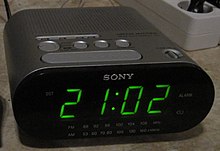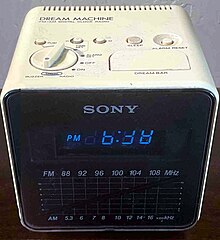This article contains content that is written like
an advertisement. (October 2018) |



Sony Dream Machine was Sony's long-running line of clock radios. The line was introduced in the early 1960s and ran until the early 2010's. [1]
History
In the mid 1960s, Sony introduced the first Dream Machine. The basic idea is to use radio program to wake up users more pleasantly, as many would find loud mechanical alarm made by traditional alarm clocks disturbing. The use of direct-read digital display as opposed to a traditional clock dial gave the design a modernistic feel, which was much appreciated in so-called Atomic Age. It is not certain if Sony truly invented the concept of digital radio clock with Dream Machine, but it was at least among one of the first to hit the market. Earliest models were for Japan domestic market only, and since Sony has never published an official product chronicle, information on these early models have been scarce online and often in Japanese only, sourced from outdated marketing material and old catalogues.
By late 1960s Sony began to export these machines and soon they become an international hit. It was a popular choice of holiday gift by early 1970s worldwide. It was one of the first widely adopted home digital appliances. By the mid 1980's many rival products existed, although the Dream Machine line was considered premium thanks to its stylish design, high quality component, simplicity and ease of use, and good sound quality for its radio. Many original working examples survived to this day (2020s) with minimal maintenance.
For a short time in the late 2000's, the radio clock market experienced a resurgence, because of several new ones including iPod / iPhone 30 pin docks and CD players. By the early 2010's, Sony stopped manufacturing new clocks under the "Dream Machine" name. At the time of discontinuation, the name was used for over forty years.
The "Snooze" button featured in all digital alarm clock, was stylized as "Dream Bar" on a Dream Machine. In Japan, Dream Machine's Alarm function is called "Ohayo" mode which literally means "Good Morning" in English.
For certain market and era Sony would use other commercial names for their radio clock products, such as DIGIMATIC (UK/EU), or Digital 24 (US/North America), however the actual design would be identical or similar to those branded as Dream Machine.
The manufacturing of Dream Machine is an early example of outsourcing. The vast majority of Dream Machines were assembled outside of Japan, in either Hong Kong or Malaysia, and later models were mostly made in China.
Technical details
While the basic idea of Dream Machine is simply a combination of an analog radio and a digital clock, actual display technology evolved with time, from mechanical Flip Page at introduction, to VFD (1970s - 80s), and eventually to more energy efficient LED / OLED (primarily 1990s onward). Certain later models were also capable of docking digital players such as iPod and iPhone, serving as an amplifier for the external device.
Saving from a handful of 1960s models which used synchronized motor driven flip page, most Dream Machine was powered by the use of specialized Microcontroller optimized for digital clocks. With the use of one single microcontroller it is possible to keep time, drive display segments and switch the radio on and off.
Notably, Dream Machine's microcontroller uses AC mains power (at 50/60Hz) as reference signal instead of crystal oscillator. While this design gives remarkable accuracy, clock pace is not ensured outside of its intended market. Some models (like Japan or AEP model) feature a 50/60Hz switch, but for models without such a switch, the circuit shall need to be modified if intended to use in an area with a different mains frequency. An optional 6F22 backup battery (later model may use CR2032) can be installed, to prevent a probable power failure event (i.e. a blackout) from resetting the clock.
The vast majority of Dream Machine uses traditional string-pulled tuning for its radio, despite the prevalence of digital PLL tuning. This is likely to facilitate more intuitive continuous blind tuning for a user lying in bed.
Models
8FC-59W
One of the first clock radios, released in 1968. The clock displays the time by a mechanical flip mechanism. It has a alarm and also has an FM and AM radio.
ICF-CL75iP
The device has a 7 inch touch screen that can be used as a photo frame, alarm clock, radio, and iPod dock. It has a 30 pin dock on the right side of the clock. Engadget knocked the limited codec support, but lauded the attractive design and low ($149.95) announced price tag. They also suggested Sony should add Chumby widget support, [2] a wish Sony later granted with their Dash alarm clock. CNet Australia felt that although it was missing some features consumers might expect from stand-alone devices, the combination of functionality makes up for the shortcomings of each of its parts. [3]
ICF-CD3iP
Has a round face. The model's speakers were criticised, but the model has a CD tray, and was sold relatively cheap. [4]
ICF-C318
A clock radio with a large display and two independent alarms, which can be set to a radio or buzzer. Other features include a 0.9" green LED display, an extendable snooze bar, a built-in calendar with automatic daylight saving time adjustment and a lithium battery for a full power memory back up. Battery life is approximately up to 250 Days with the Sony battery. The model also has a built-in AM/FM radio, with a Ferrite bar antenna for AM, a wire antenna for FM, and mono 66mm speakers. [5]
ICF-C303
A Pill Synthesized Clock radio that had a digital tuner, and many features. Has hidden set controls that is used to set up the clock, has dual alarms, 7 preset stations, and AM and FM radio.
ICF-C218

A clock radio that is similar to the ICF-C318 with the Green LED Display, but it has a single alarm instead of a dual alarm. Same features as the ICF-C318, but it is a different design and almost as the same as the C318. It comes with two bands; FM and AM.
ICF-C273
A clock radio with three green dimmable backlit displays, one main display and two separate alarm displays. It has a white plastic body and silver blue faceplate, a PLL synthesized AM/FM tuner with five preset buttons, two alarms with either radio, beeper, or two selectable melodies as wake up chimes, and a nap button. It has no battery backup.
ICF-C414
A clock radio with an extra large Green LED 1.4 inch display, it is the same as the ICF-C318, but it is a bigger display. Dual alarms and radio bands, FM and AM. Also it has a melody alarm (ALARM B Only).
ICF-C2W
A clock radio that has a single alarm, vintage like style, and is a standard alarm clock. No battery backup.
ICF-C3W
A clock radio that is very similar like the C2W, but it has a different alarm sound, and a different time when you plug it in instead of the “12:00 AM” flash.
ICF-C10W

An FM/AM digital clock radio with a cube dimension of 4.5 inches all around. It was Probably an older generation of CXW family digital radio with more improved features like DREAM BAR on the top panel and a 9-volt battery backup at the bottom panel like C317. It must be the first model in the CXW family with the backup battery feature since it had a sticker label reminding consumers of this special feature - "POWER BACK-UP REST ASSURED SYSTEM". The front face shows the blue LEDs for the time and the bar dials for FM/AM stations. On the top panel, it had a large rectangular snooze button, and a small round ALARM RESET button in a shallow depressed hole so the Dreamer can feel the depression without looking to cancel the alarm instead of hitting the snooze bar. It also had a SLEEP button to leave the radio on from 10 minutes long to 60 minutes long with 10-minute setting intervals. It had both RADIO and BUZZER options. The right side panel has two rounded discs for VOLUME and TUNING adjustments. The left side panel is the speaker.
ICF-C12/C16
Introduced in 1981, this lineup was a hit in Japan and worldwide. The C12, nicknamed "Tomato" in Japan, has a cube shape and bright red as color option while C16 "Coffee" featured a rectangular design. Both models featured a VFD display, driven by a CMOS MCU.
ICF-C317
A clock radio produced in the early 2000s that has a large, round snooze button, as well as a buzzer/radio alarm. It supports AM and FM bands, with a tuner and volume adjuster located on the side. Shows a seconds display when you hold down the snooze button. The LEDs are green, showing a twelve hour time display, with an indicator on the left side of the face to show AM and PM. Most were made in silver and grey, with four short 'legs' at the bottom of its square body. A 9V battery can be inserted to back up time in the event of power outages.
ICF-C492
A clock radio that is similar to the C317, but it has a Large display, Same features as the C317.
ICF-C390
A clock radio with a flat, half-disc shape, in white or black body, and red or green LED display. AM and FM bands (analog tuner), dual alarms (buzzer + radio), volume knob. Mains powered but it has a 9V backup battery.
ICF-CS650
A big clock radio that has a Cassette Player, Dual alarms, AM and FM bands, and Green LED’s.
ICF-C470
A clock radio that has a different alarm sound and has a volume control and two different alarms. This one comes in the MK2 version as well, It has a red LED display, and for the MK2, it has a green LED display. The first alarm is a radio alarm and the second one is the buzzer, Two bands; FM and AM.
ICF-CD853
A clock radio with an FM Radio and a CD player. It features a 8 cm Orange LED display with different brightness options. Almost round in shape. Came in silver and black colors. Small footprint. Circa 2002.
ICF-C717PJ
The clock is long and rectangular, akin to a sound bar. The main selling point of this clock is the nature sounds for the alarm, and a rear projector that can project the time. Released in 2010.
Legacy
While "Dream Machine" is no longer used as a marketing trademark since the 2010s, the product line as well as ICF-C designation actually lives on. As of 2024, ICF-C1 is still listed as an active product.
References
- ^ @marcycohen (7 October 2011). "We don't make them anymore" ( Tweet). Archived from the original on 1 February 2022. Retrieved 3 July 2023 – via Twitter.
- ^ "Sony ICF-CL75iP alarm clock / Digital frame / IPod dock a surprisingly attractive assimilation".
- ^ "Product reviews, how-tos, deals and the latest tech news".
- ^ "Sony ICF-CD3iP CD Clock Radio for iPod and iPhone - A Review of the Sony ICF-CD3iP CD Clock Radio for iPod and iPhone". 27 April 2009.
- ^ https://docs.sony.com/release/specs/ICFC318_mksp.pdf [ bare URL PDF]